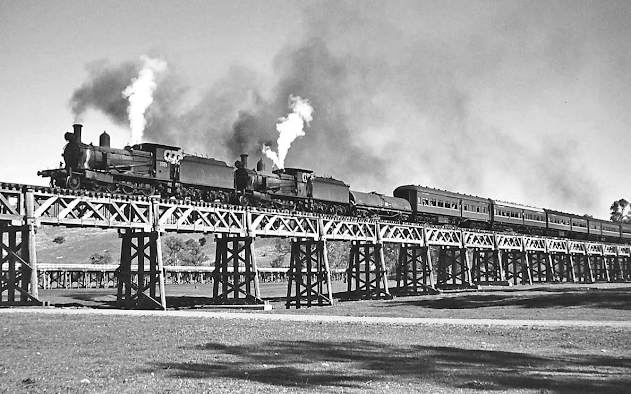The Main Center of Wentworth
Ferguson Tractor Monument that saved the town from the 1956 floods when it became an island in an inland sea, but the town fought back. The An story I got by a local was, after WW2 the soldiers from Wentworth were given land and a tractor (Ferguson) but when in 1956 flood waters threatened the town it was the Massey Ferguson (35 in all) worked day and night building a levee that saved the town. A fitting monument with the quotation: "By God and by Fergie we beat the flood".
Flood levels reach a high in the 1956 floods the Darling River was estimated to be up to 112km wide but it was the Ferguson tractor that came to the rescue of Wentworth at the junction of the two great rivers and to this day is still hailed as the town's saviour. They were the only size tractor which could fit on the town's levee banks at the time.
We removed our bikes to ride around the town only Desie’s was flat so I left him and went exploring and found the Wentworth Port.
This is a familia site along the Murray with the many Houseboats monopolising the banks.
I walked along the river where dead Carp lay everywhere, if you catch them it’s illegal to throw them back, so they lie on the riverbank, rotting away and stinking.
Captain John Egge came to Australia as a crew member on a vessel whose Captain’s main interest was for the honour of being the first riverboat to navigate the Murry. He became the owner of many establishments and was reported in 1881, that John was paying something like £1,800 to £2,000 a month in customs duties and was renowned as the merchant with the best credit in all the colonies.
The Wharf was originally built in 1879 and was a major landmark of the town when boats, were a way of life' in the town on the Darling and Murray Rivers, during one week 31 steamers were docked at the wharf, but unfortunately the original wharf deteriorated and was demolished in 1983. A replica was built (including the little customs office) and now stands in its place.
Possum Man (David Jones), came from NZ at the age of 27 years to make his fortune as a shearer, only he arrived in hard times and was refused work, he turned his back on society and survived by trapping rabbits, foxes or wild cats along the river country from Wentworth to Renmark. Because he slept in the fork of a tree during the hot summer nights, he was nicknamed "Possum" after spending 54 years as a bush recluse. Following the discovery of his body in 1982, $1200 was raised by the township for his funeral, more than 200 people attended the service. The headstone reads 'David James Jones - Possum - 1901-1982 ; At rest where he roamed.'
I walked into what I thought was a hardware that run by an elderly couple, it’s also a secondhand shop, that’s cluttered and very dusty.
The sculpture represents the connections between time, place, the environment, nature and mankind the sacredness of nature the effect that man has on the environment how man should venerate the earth and walk lightly upon it the spirit of the earth in relation to culture and race the inner spirituality of all people these are ideas and issues I think about when I am making sculptures.
Riverboat Rod’s Model Paddle Steamer Display
I came upon this by accident, it’s possibly the largest and only collection of its kind in the world, with over 30 hand-made replicas hand-crafted with amazing detail. Rod has put in a lifetime of work constructing each Paddle Steamer as closely as possible to original design which ranged between 300 and 700 hours of work.
Paddle Steamer Pearl
Rod’s words:Normally I do not use any plans for making my model boats as I get lost trying to follow them anyway. I have a hard time following a street directory, then I still get lost. I make all of my boats from whatever pictures I can find in books and lots of photos.
A replica of Ruby and the story of its restoration was due to private donations by the locals that took years of hard work, then on 16 May 2007, Ruby was steamed up for the first time in over 70 years, and the sound of her steam whistle was heard throughout the town of Wentworth.
The attention to detail are exceptional Rod’s a man with many patients
This piece was given to Rod who had no idea where or who did it, it’s made from many matchsticks and is now well preserved in Rod’s Riverboat Desplays, in the town centre.
I was walking the grounds when I came upon the Old Wentworth Gaol that was built with one million bricks and slate and was the first Australian-designed gaol. Built from 1879-1881 and was copied by the gaols built at Hay and Dubbo. It was a relatively small prison for serious offenders with 10 male and 2 female cells, a massive 45-cm thick walls, lookout towers, a stretching rack, a whipping stool, stocks, and shackles set into a boulder in the unshaded centre of the courtyard, the gaol closed in 1929 and was unfortunately closed when I noticed it.
Directly opposite the gaol you will find the museum that has over 3000 items which includes fossil remnants, a giant kangaroo and of cause a collection of river boats photographs and much more but it was also closed.

























Comments
Post a Comment